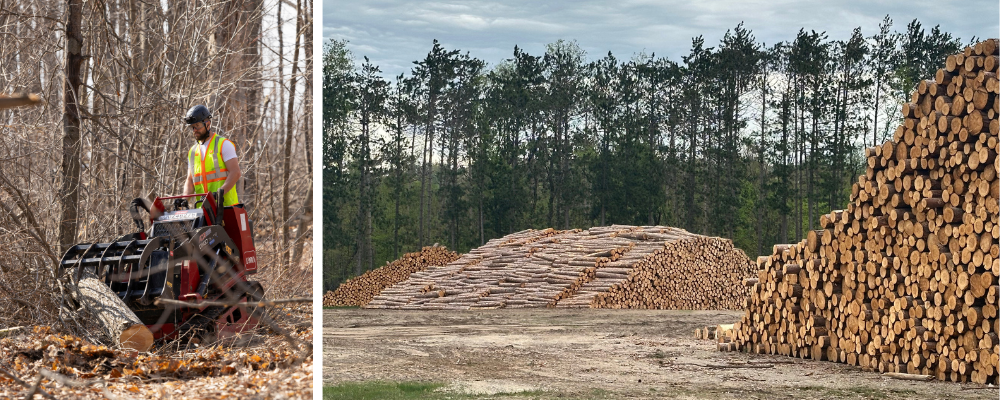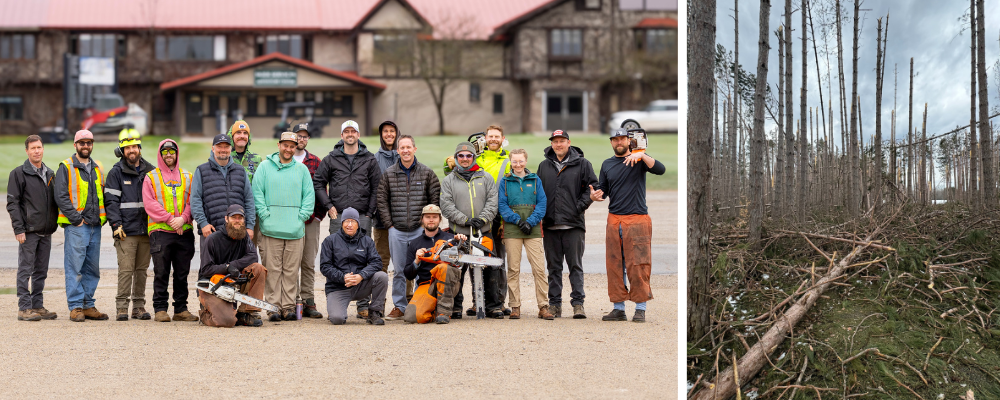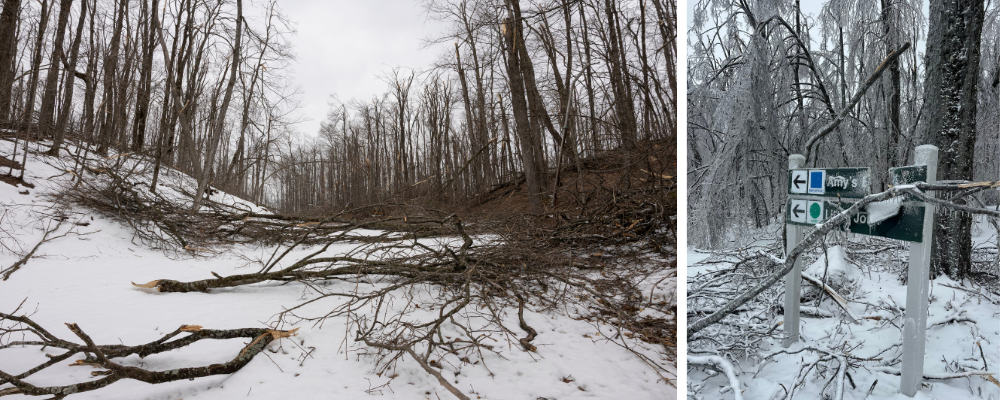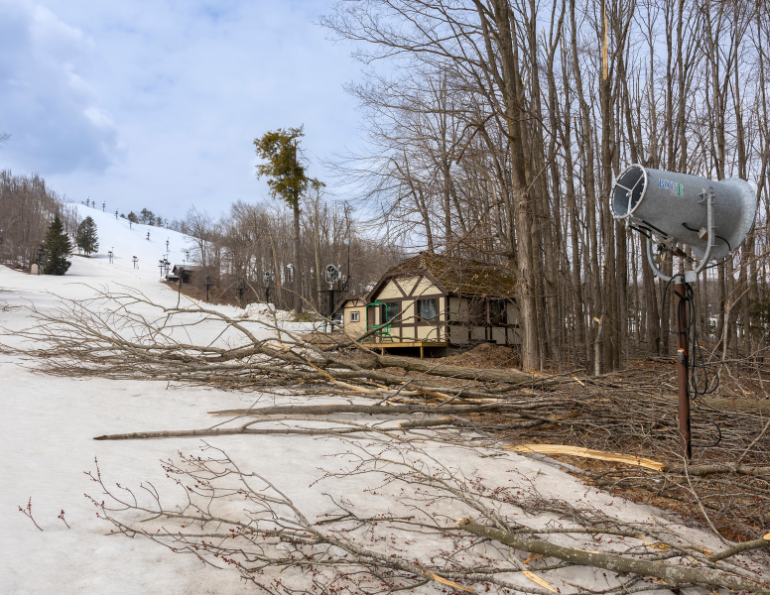Ice storms are something of an occupational hazard in the ski industry. Every operator knows the sight of glazed branches and iced-up haul ropes. Less than a quarter inch of radial ice accretion is considered a nuisance event. The 2 inches of ice accumulation in a small corner of northern Michigan at the end of March was devastating.
The three-day storm, March 28-30, was local to the upper section of Michigan’s Lower Peninsula and a small section of the Upper Peninsula, with the most severe impacts felt in just a handful of counties. The story never made national news, but even so, millions of acres of the region’s vast pine forests were impacted; 145,000 people were left without power, some for weeks; and the governor declared a state of emergency.
Most of Michigan’s 40-odd ski areas, many already closed for the season, escaped serious, if any, icing. The Highlands Ski and Golf Resort—owned by Boyne Resorts and, with 435 skiable acres, one of the Midwest’s largest ski destinations—was one of the few to be in the zone of extreme impact.
A surprisingly severe storm. “As the storm was happening, I don’t think anybody realized how big it was,” says The Highlands area manager Robby Ortlieb. After a night of high winds and freezing rain, Ortlieb cleared a downed tree from his driveway and rushed into work to respond to a report of another downed tree blocking access to a homeowners’ association.
It was still dark as he left home, but as the sun started to come up, Ortlieb says, “I quickly realized this is worse than anybody could imagine. It wasn’t just one tree on property. I was looking at every house I passed like, ‘Holy cow.’” Power lines were snapped in half, and branches hung low and heavy over the road. When Ortlieb’s car slid out and he hit some of the overhang, “I thought I’d shattered my windshield.” It was the ice on the tree limbs that shattered instead.
Like a war zone. Between the downed trees and power lines, Ortlieb couldn’t reach his office, so he parked as close as he could, 50 yards away. When he stepped out of the vehicle, “It sounded like a war zone, with the limbs snapping off from the trees.” It could have been mistaken for gunshots, or explosions.
When Ortlieb got on his snowmobile to conduct a sweep of the property, he couldn’t find an access point on to the hill to check the lift lines. At one point, he thought, “I shouldn’t be here.”
“I didn’t know what was going to come down on me,” he recalls. “There was all this crunching and snapping.”
He returned home, and the storm raged for another two days.
The aftermath. When staff was finally able to survey the property, it was grim. “Every corner had an incredible number of limbs and trees down,” says general manager Mike Chumbler. “The first 24 to 36 hours, we had to be mostly aware of the imminent danger of trees and limbs coming down, and it really made the working environment hazardous.”
Compounding it all, says resort services director Mari Kissinger, was the cold. “That ice lingered, and that weight and that tension and that pressure just stayed on.”
 Left to right: One of the biggest challenges in the ongoing clean up has been securing enough of the right equipment and PPE for the scope of the work, much of which has taken place in dense forests; Logging companies were retained to salvage timber from myriad downed red pine stands.
Left to right: One of the biggest challenges in the ongoing clean up has been securing enough of the right equipment and PPE for the scope of the work, much of which has taken place in dense forests; Logging companies were retained to salvage timber from myriad downed red pine stands.
The Damage
In some ways, the destruction was not as bad as it could have been. There was no structural damage to key facilities, and all chairlifts were intact. Apart from a few branches on haul ropes, none of the lifts suffered major damage, a testament, says Ortlieb, to the slope maintenance team’s diligent forest management practices. (“I’d take that as a win,” he says.)
In other ways, it was catastrophic. The Highlands’ 40 acres of red pine plantations were all but destroyed, with more than 90 percent of the timber damaged. Ice accumulated in the pine canopies, causing the tops to snap off. “Our entrance looked like we had 40 acres of matchsticks just sticking out of the ground,” recalls Kissinger.
The property’s hardwoods were less affected, but in an early assessment, Ortlieb speculated “there were more trees down than left standing.” Though hyperbole, the actual scope of the damage was nonetheless significant, with enough downed limbs, dead trees, and widow-makers littering the property’s forests that the team is still cleaning them up as of reporting.
Equipment and facilities. In addition to the downed trees and limbs, portable snow guns were damaged, as was a pump house. A radio tower on the summit collapsed from ice buildup.
The resort’s four 18-hole golf courses were decimated—sitting under a thick layer of ice and covered with debris—just three weeks before they were scheduled to open.
The horse pastures and trails surrounding The Highlands’ equestrian center were destroyed.
The zip tour had to be written off.
In addition to the 55 developed ski trails littered with debris, there were 22 miles of mountain biking trails to clear, as well as hiking and segway-tour trails to restore.
For perspective, says Kissinger, “When we finally got up on the hill, I went up there with our bike park manager. We’re standing at the top of one of our bike trails. We see the trailhead sign, so we know the trail is right there, but neither one of us could tell where it was.”
Feeling powerless. On top of it all, the power was out—and it remained out for six weeks on parts of the property, says Kissinger.
“It was overwhelming,” adds Chumbler. “By day three or four, Robby (Ortlieb)and I would just look at each other like, ‘how are we going to get this place looking even remotely normal by spring?’”
The Remediation
The first order of business was to push debris off the roads so that emergency vehicles could pass if needed, though essentially, in that first week, “we couldn’t even go on the hill,” says Chumbler; the ice-loaded trees were too unpredictable.
“We couldn’t start cutting trees down right away because of that built-up pressure and ice that was on them,” adds Ortlieb. “They were snapping up in your face.”
 Left to right: Post-storm clean up was a team effort that brought together dedicated local staff as well as folks from across the Boyne Resorts network; Canopy ice accumulation caused many trees to snap, leaving The Highlands’ red pine plantations looking like rows of matchsticks.
Left to right: Post-storm clean up was a team effort that brought together dedicated local staff as well as folks from across the Boyne Resorts network; Canopy ice accumulation caused many trees to snap, leaving The Highlands’ red pine plantations looking like rows of matchsticks.
Recruiting help. The resort had already closed for winter when the storm rolled through, with 80 percent of the mountain ops team laid off for shutdown, says Ortlieb. “I thought, ‘I’m going to have to make calls and be like, ‘Just kidding. We need an army of workers just to help make our roads accessible.’”
“We needed manpower quickly,” adds Chumbler, “but our teams had to deal with their own major issues and damage at their respective homes.”
Offering help. While thousands of folks were without power for weeks, including Chumbler, Kissinger, and Ortlieb (who was collecting water from a lake for his donkeys and sheep), proximity to a substation meant the lights were back on in The Highlands’ main lodge and hotel after three days.
With the help of on-site staff, the resort offered up beds, hot showers, and meals to more than 50 staff members and their families and pets, as well as 115 linemen, who were deployed to the region to repair thousands of miles of damaged power lines.
“It really worked in our favor to get people safe and provide them with electricity,” says Kissinger. “People were able to shower, but it also got us a head start on cleaning up our resort.”
Staying flexible. “We had pockets of crews,” says Chumbler. “Every morning, we’d divide them up based on equipment, based on skill set, based on need.” The scope of the remediation work was daunting, he says, though staff gained momentum daily.
There was a no-schedule schedule in place. Team members were empowered to “come when they could and give what they could,” says Kissinger. The morning meeting was held on the later side—at 9 a.m., says Ortlieb—to better allow folks to take care of challenges they were still grappling with at home. “I think, as managers, it’s our job to remember how human everybody is,” he adds.
Safety first. Safety was a priority, and conditions were evolving daily, says Ortlieb. “We were making sure everyone was outfitted with the proper PPE. Nobody that hadn’t touched a chainsaw was just grabbing one. We didn’t skip steps. We had a kind of slowest-is-smoothest-is-fastest sort of thing.”
Getting by. Equipment was hard to come by. “We needed five times the amount of PPE we had,” says Chumbler. Kissinger couldn’t find a woodchipper for rent within a 200-mile radius. She had to start checking in Illinois and Wisconsin. In-house equipment took a beating from the ice. “Mirrors were getting ripped off of the sides of vehicles,” says Ortlieb.
The People
The core remediation crew started with just five people and quickly swelled to 30. Alongside the in-house crew was an influx of contractors.
“The number of outside contractors we had to hire was staggering,” says Chumbler. Arborists were brought in to triage the trees, especially on the golf courses, and logging companies were retained to salvage what timber they could from the pine plantations.
Family to the rescue. The Highlands also leaned on its Boyne family. With many resorts winding down for the season, “we put the call out,” says Jeremy Cooper, VP of mountain sports development for Boyne Resorts, who helped rally additional assistance. “I went in person to both Sugarloaf and Sunday River (Maine) … and put the begging hands together,” he says. “You could see the GMs like Brian Heon or Karl Strand just point and say, ‘Hey, get these guys some help.’”
Crews came from Maine, as well as Boyne’s Loon, N.H., Big Sky, Mont., and The Summit at Snoqualmie, Wash., ski areas Some drove all the way out with equipment, others got on airplanes.
“It was important to have skilled sawyers,” says Kissinger, who coordinated the efforts. “We got the cream of the crop from the corporation, and we’re forever grateful for all of it.”
“It took a lot of people to make this work,” she adds. “We had employee housing readily available for them, and our food and beverage director came in, and we figured out how to feed them.”
It was something of a trial by fire for the food and beverage director, Justin Barnes, who was newly hired and set to start April 1. “I said, ‘Your orientation is going to be a little weird,’” recalls Chumbler. Luckily, in addition to feeding the crews, Barnes also had experience operating a chainsaw.
At the end of the day, “We built some great relationships,” says Ortlieb. “Some of the folks are still in touch with each other. It was really cool to see those connections form within the Boyne network.”
“It was neat to see the people that stepped up and the community draw together,” says Chumbler. “Leaders were born. Robby’s leadership and Mari’s, I can’t speak enough to that,” he adds. “They were on full display, and it was cool to witness.”
 A spring storm glazed The Highlands in up to 2 inches of radial ice. The pressure and tension from the accumulation left some infrastructure and assets damaged and thousands of trees downed or wounded. The remediation effort has been months-long and remains ongoing.
A spring storm glazed The Highlands in up to 2 inches of radial ice. The pressure and tension from the accumulation left some infrastructure and assets damaged and thousands of trees downed or wounded. The remediation effort has been months-long and remains ongoing.
The Learns
While much has been accomplished, recovery is ongoing. Kissinger estimates, “between our outside help, our inside help, our visiting help, we’re in over 15,000 man-hours of labor just focused on storm cleanup. We probably have another 5,000-plus hours to go before the season hits. We still have to get into our gladed areas and beyond, because there are still trees that are snapped in half and hangers.”
Summer business rebounded, but not without effort. Golf opened nearly on time—just one course was delayed by a week. Mountain biking was slow to restart, but it and most other summer activities resumed.
There were casualties. The adventure business was a total loss, which may be fortuitous. “Zip lining had been flatlining a bit,” says Chumbler. “We’ve got estimates for a new zip tour, and we think there’s an opportunity to reimagine it.”
Assets for the winter Enchanted Trail nighttime light walk were also destroyed, but it had already been slated for relocation. That plan now has momentum, says Kissinger.
Despite it all, the resort is “OK, revenue-wise,” says Chumbler, and doesn’t anticipate closing any terrain this winter.
But “given the extent of trail clearing and maintenance work to be completed, we’re going to need every bit of the summer to get ready for winter,” he adds. “We’ve been estimating it takes about one week per run.”
Managing future risks. The risk management side has seen some positive outcomes. Power lines that were previously overhead have been moved underground. The slope maintenance team will continue its proactive tree auditing practices and is now better equipped for future weather events.
“We now have the right equipment on property,” says Kissinger. “Woodchippers, PPE, all of it.”
What could have been done differently? “There’s not much you can do to prepare for something of this magnitude,” says Chumbler. “They called it a hundred-year storm. We’ll probably get one every three years now.”
Chumbler was joking, but his suggestion is supported by the fifth Congress-commissioned National Climate Assessment, published in 2023, which found an increase in severity, extent and/or frequency of multiple types of extreme events, including major storms—a reality experienced on the ground at many mountain resorts as they grapple annually with flooding, fire, and sometimes to their benefit, extreme snowfall.
Controlling one’s own destiny. Highlands has had to rely on its own resources to manage its recovery. Federal and state assistance have been nonstarters, and insurance claims are progressing at “a glacial pace,” says Chumbler. But the team remains grateful in the face of such a large-scale remediation effort.
“I think it brought a lot of great out of people,” says Ortlieb. “Just imagine hanging out with a crew, feeding a woodchipper for eight hours a day. You’re going to bond, I promise you that.”
“We all just did what we could for each other,” adds Chumbler. “You wouldn’t believe how many people still thank me for us opening the hotel, for letting them stay there, for feeding them a meal a day, how much that meant to them. It was a challenge, but we had some good come out of it, for sure.”






